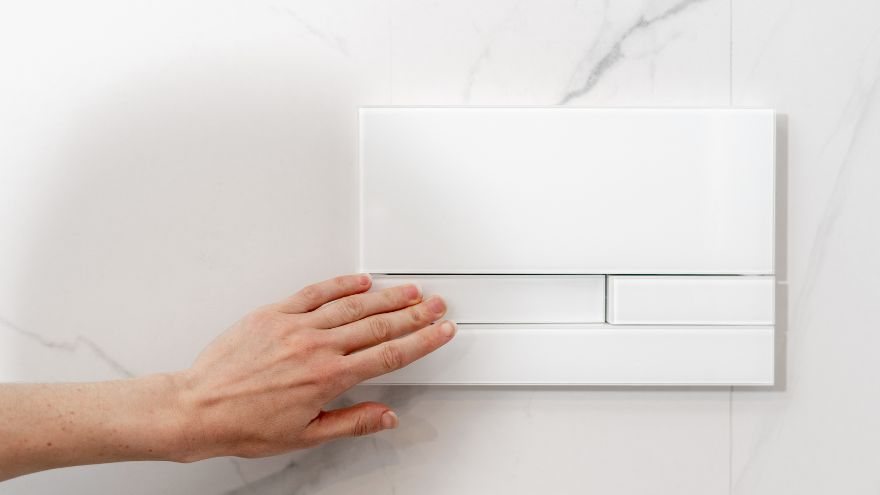The concealed cistern is a modern solution in bathroom equipment that combines aesthetics with functionality. Unlike conventional models, the concealed cistern is hidden in the wall, and only the flush button remains visible. Despite its many advantages, this design requires special attention during repairs and maintenance. The installer who undertakes repairs of this type of device should know the most common failures and methods of their removal.

Check out the concealed cisterns at the Onninen wholesaler
How to repair a concealed cistern when there is no water flow?
 One of the most common problems that installers encounter is a lack of water in the tank. It is important to be able to recognize a cistern failure and take steps appropriate to the cause of the mechanism failure. Needless to say, the number of failures can be limited by a well-selected and certified concealed cistern .
One of the most common problems that installers encounter is a lack of water in the tank. It is important to be able to recognize a cistern failure and take steps appropriate to the cause of the mechanism failure. Needless to say, the number of failures can be limited by a well-selected and certified concealed cistern .
Symptoms of damage to the concealed cistern:
- No water when pressing the flush button.
When you press the button, there is no sound of the tank filling or water draining. - Constant noise in the wall.
This indicates a blocked inlet valve or leaks in the pipes. - Water does not flow into the tank, but other water installation elements in the bathroom are working properly.
This may indicate clogged pipes supplying water to the concealed cistern . - The float valve remains in the closed position.
One common problem is that the float mechanism becomes contaminated with limescale or scale deposits. - The flush button is difficult to operate or does not respond to pressure.
This may indicate mechanical damage to the lever or a blockage in the water flow control mechanism.
Diagnosing and repairing problems related to the lack of water in the concealed cistern requires taking several steps:
Checking the inlet valve:
- Make sure the water supply valve to the flush tank is fully open;
- If the valve remains open and water does not flow, check if it is blocked by dirt. It is recommended to dismantle and clean it.
Float control:
- Remove the service panel and assess the condition of the float;
- Clean the mechanism from mineral deposits using scale-eliminating agents;
- Make sure the float moves freely and returns to the starting position.
Removing contaminants from water supply pipes:
- Disconnect the inlet pipes and flush them with pressurized water;
- In case of stubborn contamination, use compressed air or specialist tools.
Seal verification:
- Check the condition of the seals in the valve and, if necessary, replace them with new ones;
- Use seals compatible with the given cistern model, which can be found in the range of concealed frames at Onninen.
Testing the operation of the flush button:
- Once you have determined that the problem lies in the control mechanism, you should check the condition of the levers and control cables;
- In case of damage, replace the faulty elements with new ones adapted to the flush model.
The repair procedures presented can be carried out independently, but in the case of more complicated faults it is worth reaching for proven components that ensure durability and reliability. The quality and precision with which the flush-mounted frames were made are also important.
Thanks to the above tips, the installer can quickly diagnose the problem and effectively restore the correct operation of the concealed cistern, ensuring its long-term efficiency. Safe access to the structural elements will be facilitated by a set of appropriate tools, which should include socket wrenches and pliers.
How to get to a concealed cistern?
 Access to the concealed cistern is possible via the service panel located in the location of the flush button. The installer should carefully remove the panel, using tools that will not damage the surface. In the case of older models, access to the mechanism may require greater caution due to the unusual design.
Access to the concealed cistern is possible via the service panel located in the location of the flush button. The installer should carefully remove the panel, using tools that will not damage the surface. In the case of older models, access to the mechanism may require greater caution due to the unusual design.
To access the concealed cistern:
- Remove the flush button according to the manufacturer's instructions;
- Inspect the mechanism components such as the drain valve and seals;
- If necessary, replace worn parts using components available in concealed toilet frames offered by wholesalers.
Can a concealed cistern be adjusted?
Adjusting the concealed cistern is a common need, especially after a long period of use. Correctly setting the float and drain valve allows for optimal use of water and avoiding leakage problems.
 Adjusting the concealed cistern:
Adjusting the concealed cistern:
- Setting the float at the appropriate height to prevent water from overflowing;
- Loose mechanism parts such as valves or handles must be tightened;
- Test the operation of the flush button, ensuring it operates smoothly and without resistance.
In concealed cistern repairs, the right tools and components are essential. The installer should use proven products, such as concealed frames , which guarantee durability and compatibility with different models.
Onninen Wholesale offers a wide selection of accessories and spare parts:
- seals and valves;
- control mechanisms;
- tools for removing service panels.
Professional flush-mounted toilet frames available in wholesalers allow for quick and effective repairs. Installers will also find high-quality bathroom accessories that meet the highest standards.
Check out the full offer of the Onninen wholesaler and choose components that will facilitate repairs and ensure the reliability of the flushing mechanism.